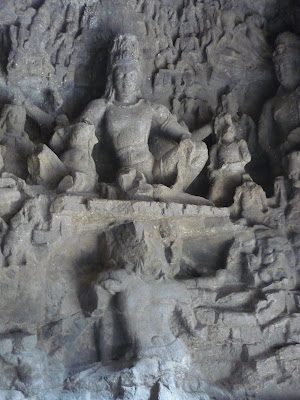Today I took an hour long ferry ride from the Gateway of India to the cave temples on Elephanta Island. In the picture below to the left of the Gateway of India you can see the Taj Mahal Palace and Tower Hotel that was where the horrendous terrorists attacks happened on November 26 -29, 2008
Elephanta Island is home to an impressive number of temple carvings, which became a Unesco World Heritage Site in 1987. The temples are believed to have been created between 450 and 750 AD, when the island was known as Gharapuri (Place of Caves) before the Portuguese renamed it Elephanta because they found a large stoned elephant that greeted them near the shore. Unfortunately, the large Elephant collapsed in 1814 and was moved by the British to Mumbai’s Veermata Jijabai Bhonte Udyan.
The Portuguese took control of the island in 1534 AD and most of the damage to the statues are the result of the Portuguese soldiers using them for target practice and testing the echo of their guns inside the caves.
Once you reach the island you can take a train or walk the short distance to the foot of the hill. From the bottom of the hill the caves are a ¼ of a mile climb (120 steps) that are lined by hawkers trying to sell you all the normal souvenirs and soda loving monkeys. If you don't want to climb the 120 steps you can be carried like a Pharaoh up to the top.
These monkey were pretty calm and not that much of a nuisance.
The main cave (almost 130 square feet) is a Shiva dedicated temple that has numerous rooms that house many intricate carvings.
The focal point is a large 18 foot height statues of Sadhashiva that depicts the three-face Shiva: Destroyer (Left - notice the mustache and serpents), Creator (Center - notice the calm face), and Preserver of the Universe (Right - female aspect and holding a lotus flower). There is said to be a fourth face, but it is not visible.
Mahayogi Shiva or Shiva as Lord of Yogis
Natraj Shiva or the King of Dancers
Ardhanarishwar-Shiva - this sculpture shows Shiva, one half of whose body is female, leans against the bull Nandi, the upper hand holding a snake and a mirror. This fusion of the male and the female bodies is a symbol of the Divine Unity, where all opposites are resolved.
Gangadhara-Shiva (Descent of the Ganges)
Shiva Shrine (The Lingam Sanctuary) - shrine has four doors that are guarded by dvarapalas or door keepers. It is still worshipped at religious fairs to this day. And, it was a good thing that I decided to go to the island today because tomorrow there is a huge celebration and over 50,000 people are expected. Although, it would have been nice to see the festival I wouldn’t have gotten to see anything else. I could not imagine having all those people converge upon the tiny island that is home to three villages and a total population of 1600 people.
Andhakasura Vadh (Shiva as Killer of the Demon Andhaka) - Shiva is depicted angry, his body surging forth from the rock, with a sword in his hand, as he impales the mutilated demon, below he holds a cup to catch drops of blood that drips from Andhaka’s body to prevent the creation of any other demons.
Kalyanasundara Murti (Marriage of Shiva and Paravati) - Notice that she is to Shiva’s right, indicating that the actual marriage hasn’t taken place yet, for even in the present day the bride is to the right before marriage but as wife stands always to her husband’s left.
Ravananugrah-Murti or Ravana-Shaking Kailas - The panel shows the Hindu legend in which the demon Ravana tried to uproot the Himalayas, the abode of Shiva. Although he manages to shake and lift the mountain, whereupon Shiva pressed the toe of his left foot on the ground resulting in the mountain settling back to its original position.
Besides the main cave there are a couple other smaller caves.
Ganesh
View from the top of the hill

































No comments:
Post a Comment